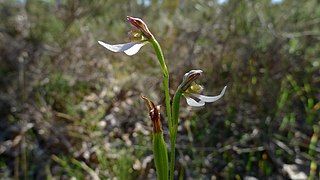
Eriochilus, commonly known as bunny orchids, is a genus of flowering plants in the orchid family, Orchidaceae that is endemic to Australia. Orchids in this genus are distinguished from those in the similar Caladenia by having a glabrous leaf and a densely woolly labellum. Species occur in south-west Western Australia, South Australia, Queensland, New South Wales, the Australian Capital Territory, Victoria, and Tasmania. Their common name alludes to their prominent ear-like lateral sepals.

Caladenia flava subsp. flava, commonly known as the cowslip orchid, is a species of orchid endemic to the south-west of Western Australia. It is a relatively common orchid with a single, hairy leaf and up to three golden-yellow flowers which often have red markings.
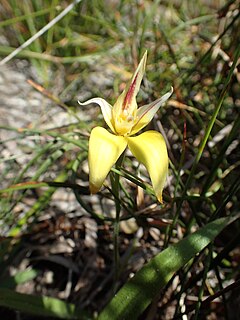
Caladenia flava subsp. sylvestris, commonly known as the karri cowslip orchid, is a species of orchid endemic to the south-west of Western Australia. It has a single, hairy leaf and up to three pale yellow and cream-coloured flowers which are white near the tips of the sepals and petals and marked with bright red or pink.
Caladenia hiemalis, commonly known as the dwarf common spider orchid is a species of orchid endemic to the south-west of Western Australia. It has a single, hairy leaf and one or two, cream-coloured flowers with a small, red-striped labellum. It has an early flowering period and its flowering is stimulated by summer fires.
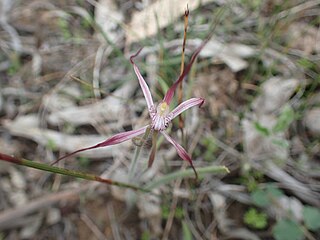
Caladenia occidentalis, commonly known as the ruby spider orchid, is a species of orchid endemic to the south-west of Western Australia. It has a single erect, hairy leaf and one or two pinkish-red flowers with a white, red-striped labellum.
Caladenia postea, commonly known as the dark-tipped spider orchid, is a species of orchid endemic to the south-west of Western Australia. It has a single erect, hairy leaf and up to three small, pale creamy-white flowers. It has a relatively late flowering period compared to similar spider orchids.

Caladenia pulchra, commonly known as the slender spider orchid, is a species of orchid endemic to the south-west of Western Australia. It has a single erect, hairy leaf and up to three red, yellow and white flowers, although the relative amount of each of these colours is variable.
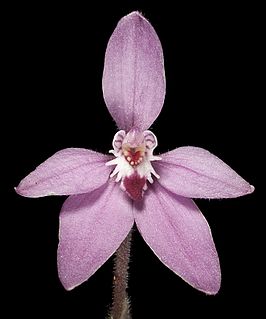
Caladenia reptans subsp. reptans, commonly known as the little pink fairy or dwarf pink fairy, is a plant in the orchid family Orchidaceae and is endemic to the south-west of Western Australia. It has a single hairy leaf and up to three relatively small, pink flowers which have a labellum with three distinct lobes.
Caladenia reptans subsp. impensa, commonly known as the pale pink fairy, is a plant in the orchid family Orchidaceae and is endemic to the south-west of Western Australia. It has a single hairy leaf and up to three pale pink flowers which have a labellum with three distinct lobes. It is similar to subspecies reptans except that its leaf is green on both sides and the flowers are larger and on a taller flowering spike.
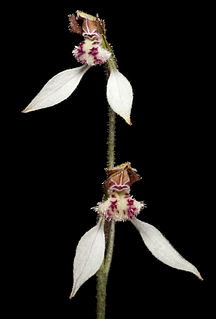
Eriochilus helonomos, commonly known as the swamp bunny orchid, is a plant in the orchid family Orchidaceae and is endemic to Western Australia. It has a single pointed leaf and usually a single white or cream-coloured flower with reddish brown markings. A relatively common species, it usually grows in swampy places. It is distinguished from other bunny orchids by the arrangement of its petals.

Eriochilus dilatatus subsp. dilatatus, commonly known as the white bunny orchid, is a plant in the orchid family Orchidaceae and is endemic to Western Australia. It has a single narrow leaf and up to seven greenish and white flowers with reddish or mauve markings. A widespread and common species, it grows in a range of habitats and flowers prolifically after fire.
Eriochilus dilatatus subsp. brevifolius, commonly known as the blunt-leaved bunny orchid, is a plant in the orchid family Orchidaceae and is endemic to Western Australia. It has a single small, smooth leaf with wavy edges and a pale red lower surface, and up to three greenish and white flowers with red or mauve markings. It is distinguished from the other subspecies by the colour of the lower surface of its leaf and by its later flowering period.
Eriochilus dilatatus subsp. magnus, commonly known as the Easter bunny orchid, is a plant in the orchid family Orchidaceae and is endemic to Western Australia. It has a single large, smooth, flattened leaf and up to twenty five dull green, red and white flowers. It is found in high rainfall areas between Perth and Albany.
Eriochilus dilatatus subsp. multiflorus, commonly known as the common bunny orchid, is a plant in the orchid family Orchidaceae and is endemic to Western Australia. It has a single short, smooth, flattened, egg-shaped leaf and up to twenty dull green, red and white flowers which are often closely packed. It grows in forest and woodland between Perth and Albany.
Eriochilus dilatatus subsp. orientalis, commonly known as the eastern bunny orchid, is a plant in the orchid family Orchidaceae and is endemic to Western Australia. It has a single short, smooth, flattened, egg-shaped leaf and up to seven dull green, red and white flowers on a fleshy flowering stem. It only occurs on the coast near Caiguna.

Eriochilus dilatatus subsp. undulatus, commonly known as the crinkle-leaved bunny orchid, is a plant in the orchid family Orchidaceae and is endemic to Western Australia. It has a common orchid in the wheatbelt and has single narrow egg-shaped leaf with wavy edges and a maroon underside. Up to three dull green, red and white flowers are borne on a wiry flowering stem.

Eriochilus dilatatus, commonly known as the white bunny orchid, is a plant in the orchid family Orchidaceae and is endemic to Western Australia. It is a common and widespread, slender ground orchid with a single leaf and up to fifteen small white and greenish flowers with reddish or brownish markings and a hairy labellum.
Eriochilus pulchellus, commonly known as the granite bunny orchid, is a plant in the orchid family Orchidaceae and is endemic to Western Australia. It has a single egg-shaped leaf and up to ten small white flowers with red markings. A relatively common species, it grows in shallow soil on granite outcrops. Its fleshy leaf is held above the ground on a thin stalk.

Eriochilus scaber is a plant in the orchid family Orchidaceae and is endemic to Western Australia. It has a single leaf and up to three small red, pink and white flowers. Two subspecies are recognised based on the shape of the leaf and its height above the ground.
Eriochilus tenuis, commonly known as the slender bunny orchid, is a plant in the orchid family Orchidaceae and is endemic to Western Australia. It has a single egg-shaped leaf lying flat on the ground and one or two small pink or pink and white flowers. A common species, it grows in dense, shrubby forest and in winter-wet swamps.








